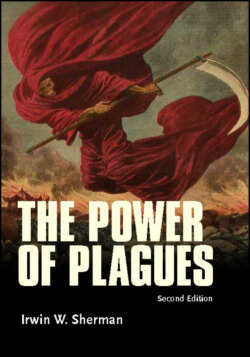Читать книгу The Power of Plagues - Irwin W. Sherman - Страница 9
Оглавление
Preface to the Second Edition
Plagues, the historian Asa Briggs observed, “are a dramatic unfolding of events; they are stories of discovery, reaction, conflict, illness and resolution.” They test “the efficiency and resilience of local and administrative structures” and “expose the relentlessly political, social and moral shortcomings…rumors, suspicions, and at times violent…conflicts.” This book was written to make the science of epidemic diseases—plagues—accessible and understandable. It is a guide through the maze of contagious diseases, their past importance, the means by which we came to understand them, the methods and practices for control and eradication, and failing this how they may affect our future.
My objective in writing the Power of Plagues has been to provide an understanding of epidemic diseases and their impact on lives past, present and future. As a biologist I wanted to examine infectious diseases that have been and continue to afflict humankind. In this 2nd edition I describe the nature and evolution of a selected group of diseases and then aim to show how past experiences can prepare us for future encounters with them. It is also a status report of where we are today with infectious diseases that are emerging and re-emerging to inflict harm not only to the individual but to larger segments of the world’s populations. This edition covers modern disease outbreaks, such as anthrax, cholera, Ebola disease, HIV, influenza, Lyme disease, malaria, tuberculosis, and Zika disease, as well as the threat of antimicrobial resistance.
For decades it has been a commonly held belief that all epidemic diseases in the developed world could be eliminated by vaccines, as was the case with smallpox. If not, then we deluded ourselves that new and more powerful chemotherapeutic agents and antibiotics would be developed and these could be relied on to cure an emerging new disease. Some of us were convinced that our water was safe to drink and our food could be eaten with little fear of contracting a disease and that the transmitters of disease—mosquitoes, flies, lice, ticks and fleas—could easily be eliminated by the spraying of deadly insecticides. If by chance a few of our neighbors became infected, some held the illusion that the infected individuals would be treated quickly and effectively so that a severe disease outbreak could be averted.
These views, however, have come to be challenged: drug-resistant tuberculosis emerged as a worldwide threat, and there were outbreaks of hantavirus and SARS (severe acute respiratory syndrome) in 2012 and 2003, respectively. In the summer of 1999 an outbreak of West Nile virus (WNV) caused illness in 62 people and 7 died. This took place in New York City, not Africa. Then in 2001 there was a terrorist attack of anthrax that killed 5 and sickened 17 in New York City, Florida, and Washington, DC. A particularly lethal bird influenza—one that killed millions of animals in a dozen Asian countries—caused alarm in 2004. This virus, which rarely infects humans, spread rapidly in the population and killed 42 people. If this “new” flu had been able to be transmitted from person-to-person by coughing, sneezing, or even a handshake, then a natural bioterrorist attack would have occurred. An outbreak of Ebola disease in Africa in 2014 and an outbreak of Zika disease in Brazil and the Caribbean in 2015 caused public health authorities to sound alarms that these might be forerunners of a pandemic. Luckily, the doomsday scenarios were not realized. But in the future, might a pandemic occur? And if there is such a catastrophe, how will we deal with it?
This book has been conceived as a conversation about how we came to understand the nature of severe outbreaks of epidemic disease—plagues. It tells about the microbe hunters who were able to identify and characterize the infectious disease agent, its mode of transmission, and how control was effected and health restored. It tells of the ways in which plagues and culture interact to shape values, traditions, and the institutions of Western civilization.
As with the previous edition, I have not taken a chronological approach in the examination of the plagues that have afflicted humans. Chapters have been written so that they are more-or-less independent and as a result they need not be read in a proscribed sequence. However, in some instances readers may attain a somewhat better understanding when the chapters on principles and protection (Chapters 1, 10, and 11) as well as the Appendix on Cells and Viruses are read early on. Some readers will be disappointed that their “favorite” plague has not been included in these pages. To have added many more epidemic diseases would have made the book much longer and encyclopedic—something I wanted to avoid. Rather, the particular plagues included have been selected for their value in teaching us important lessons. The style of the Power of Plagues is such that readers without any background in the sciences should easily be able to understand its message. This book is intended to promote an understanding of infectious disease agents by a sober and scientific analysis and is not a collection of horror stories to provoke fear and loathing. Learning about how infectious diseases have shaped our past has proven to be an exciting and enlightening experience for me. My hope is that readers of this book will also find that to be true.
